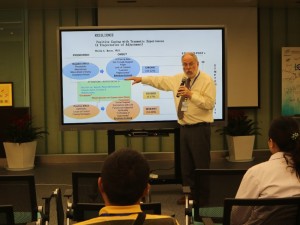What are the cognitive benefits of integrating with nature?
In the last two decades children are gradually spending more time playing video games or staring at computer screens and this has been a perpetuating problem in modern society.Richard Louv, author of the book, ‘Last Child in the Woods: Saving Our Children From Nature-Deficit Disorder’,tells the story of interviewing a child who told him that he liked playing indoors more than outdoors ‘because that’s where all the electrical outlets are.”

This culture of sitting for long periods playing games on various media such as IPad, phones, games consoles and watching television, usually while munching calorie dense snacks has led to childhood obesity and serious health threats for children including type 2 diabetes, heart diseases, sleep apnea as well as social and psychological problems. According to data from the National Health and Nutrition Examination Survey (NHANES) and the Center for Disease Control and Prevention (CDC), about 17 percentof children and adolescents aged 2 to 19 are obese, a number that has tripled since 1980. The average American child is said to spend 4 to 7 minutes a day in unstructured play outdoors, and over 7 hours a day in front of a screen.
In the past decades the benefits of connecting with nature has been well documented in many scientific studies and publications. This body of research shows that children’s social, psychological, academic and physical health is influenced in a positive way when they have daily interaction with nature. The research by Faber Taylor, A., Kuo, F. E.,Sullivan, W.C, (2001) supported the hypothesis that: Attention deficit symptoms will be more manageable after activities in green settings than after activities in other settings.‘Nature is important to children’s development in every major way- intellectually, emotionally, socially, spiritually and physically’. (Kellert, 2005).
How can interacting with nature improve a child’s self-esteem?
Many studies show the positive links between direct experiences in nature and children’s mental, emotional and physical health and well-being. These studies show that regular direct access to nature can have benefits in the following areas of a child’s development:
Benefits to cognitive development:
Proximity to, views of and daily exposure to natural settings increases children’s ability to focus and enhances cognitive  ability (Wells 2000). Nature activates more senses and awakens a child’s multi-sensory interaction with the environment for examples through visual input of multiple arrays of colors, olfactory experiences linked to visual and tactile input such as looking at and touching leaves and flowers. “As the young spend less and less of their lives in natural surroundings, their senses narrow,” Louv warns, “and this reduces the richness of human experience.” Children develop a special sense of wonder when they interact with nature. This nurtures their inquisitiveness and encourages more exploration of the world around them.
ability (Wells 2000). Nature activates more senses and awakens a child’s multi-sensory interaction with the environment for examples through visual input of multiple arrays of colors, olfactory experiences linked to visual and tactile input such as looking at and touching leaves and flowers. “As the young spend less and less of their lives in natural surroundings, their senses narrow,” Louv warns, “and this reduces the richness of human experience.” Children develop a special sense of wonder when they interact with nature. This nurtures their inquisitiveness and encourages more exploration of the world around them.
Early experiences with the natural world have been positively linked with the development of imagination and a sense of wonder. A sense of wonder is an important motivator for life-ling learning. Children who spend time in well-designed nature-filled outdoor spaces with nurturing adults develop valuable skills across all learning domains, Miller, D.L (2007)
Benefits to academic performance
Studies in the US show that use of outdoor classrooms and other forms of nature-based experiential education support significant gain in; social studies, science, language arts and math. Students in outdoor science programs improved their science testing scores by 27% (American institute of research, 2005)
Benefits to creativity and problem solving
Studies of children in school yards found that children engage in more creative forms of play in the green areas, they also played more cooperatively (Bell and Dyment, 2006). Play in nature is especially important for developing capacities for creativity, problem and intellectual development (Cellert 2005). When children are presented with opportunities for unstructured style of play, this allows them to interact meaningfully with their surroundings. They can think more freely, design their own activities, and approach the world in inventive ways.
A number of authors talk about the importance of the middle years (6 to 12 years old) for the development of the child’s relationship with the natural world. This is a time where the sense of wonder of early childhood is transformed to a sense of exploration.Research found that participation with nature before age 11 is particularly potent in shaping both environmental attitudes and behaviors in adulthood. This foundation of empathy and connection with nature may then extend into environmentally responsible actions and empowerment, as the child grows older and discovers opportunities to develop pro-environmental behaviors.
In this era of technology, do you see nature as a healthy contrast to excessive screen time?
Nature is a healthy contrast to excessive screen time
A number of recent international surveys indicate that fewer children are experiencing nature directly, with the majority of children playing indoors more often than out. The surveys highlight that many young people are ‘glued to the virtual world’ and are far removed from nature, lacking knowledge of biodiversity and awareness of its importance.The average American child is said to spend 4 to 7 minutes a day in unstructured play outdoors, and over 7 hours a day in front of a screen.Studies conclude that further effort is needed to make nature more available to children, and to inform and empower a future generation of environmental champions.
Screen time reduces outdoor time: The first 2 years of life are seen as critical for brain development. Electronic media such as TV and IPad can interfere with exploration outdoors, interaction with peers and other people which affects social and physical development. For the older child, too much screen time can interfere with outdoor physical activity, homework, playing with friends and family (Kidshealth.org September 2010). The American Academy of Pediatrics recommends that children under 2 years old not watch any TV and those older than 2 years watch no more than 1 to 2 hours a day of quality programming.
Do you think there is a link between increased exercise and an outdoor lifestyle?
 Benefits to physical well-being
Benefits to physical well-being
Children who regularly have positive personal experiences with the natural world show more advanced motor fitness, including coordination, balance and agility, Fjortoft, Ingunn (2001). Outdoor exercise is better for children than indoors:Exercise can release endorphins into the blood stream which has a soothing effect and can help with the production of melatonin which helps with better sleep. Outdoor play encourages activities such as running, climbing, pushing, and pulling which promote muscle fitness and flexibility. ‘Children who experience school grounds with diverse natural settings are more physically active—more aware of nutrition, more civil to one another, and more creative’ (Bell and Dyment, 2006)
Interacting with nature gets children moving. Most ways of interacting with nature involve more exercisethan sitting on the couch. Not only is exercise good for kids’ bodies, but it appears to make them more focused, which is especially beneficial for children with ADHD.
Benefits to your child’s self-esteem
Interacting with nature builds confidence. The way that children play in nature is less structured than most types of indoor play. There are infinite ways to interact with outdoor environments, from the playing in the backyard or park to going on a walk or fishing at a lake. It reduces stress and fatigue and cultures a fit body and curious mind. According to the ‘Attention Restoration Theory’, urban environments require what’s called directed attention, which forces us to ignore distractions and exhausts our brains. In natural environments, we practice an effortless type of attention known as soft fascination that creates feelings of pleasure, not fatigue.
There is growing evidence that children are increasingly disconnected from the natural world. Without direct experiences in nature, research findings suggest that children are missing opportunities to enhance their health and well-being, and to develop responsible long-term environmental behavior.
Incorporating nature more into the curriculum in schools
“First-hand experiences can help to makesubjects more vivid and interesting for pupils and enhancetheir understanding which prepares them for the next stage of their lives. Teaching concepts using nature brings in a child’s multiple senses and supports interest in learning. Concepts can be taught in a practical way such as performing mathematical operations such as dividing, multiplication, fractions etc. using plants, animals and natural matter. Language teaching can be vividly and concretely supported using nature e.g. teaching descriptive and categorization language concepts (Blank levels-Marion Blank). Academic concepts such as volume, quantity, length, size, weight, are better understood by children when taught in a practical hands-on way that incorporates all other senses and this is suitably achieved through use of nature.
Getting a little dirty in the great outdoors, far from being a bad thing, helps children lead happier, healthier lives.
When we let our children play in dirt, we’re not only allowing them to explore the wonders around them, we are also exposing them to healthy bacteria, parasites, and viruses that will inevitably create a much stronger immune system. Many kids who live in an ultra-clean environment have a greater chance of suffering from allergies, asthma, and other autoimmune diseases that we would otherwise be protected from through the simple pleasure of playing with some nice common dirt.
Studies have shown that simply having contact with dirt, whether it is through gardening, digging holes, or making pies out of mud, can significantly improve a child’s mood and reduce anxiety and stress. With antidepressant use in kids on the rise, an increasing number of experts are recognizing the role of nature in enhancing kids’ mental health. Dirt can even improve classroom performance.
What benefits can nature have on a child’s Health? 
Too much time indoors leads to health issues: There is a high prevalence of vitamin D deficiency (“the sunshine vitamin”) among infants, children, and adolescents worldwide. Too much time spent indoors keeps children from getting enough sunshine exposure. Vitamin D deficiency is a risk for rickets and may be a risk factor for developing cardio-vascular diseases, cancer or autoimmune conditions, (Huh S, Gordon CM)
More time spent outdoors is related to reduced rates of nearsightedness, also known as myophia, in children and adolescents (American Academy of ophthalmology, 2011)
Time spent outdoors improves social relations. Children will be smarter, better able to get along with others, healthier and happier when they have a regular opportunities for free and unconstructed play in the outdoors.
Outdoor play increases fitness levels and builds active and healthy bodies. Being outside improves distance vision and lowers the chance of nearsightedness. Research also shows that children who grow their own food are more likely to eat fruits and vegetables and show higher levels of knowledge about nutrition (Waliczek and Zajicek, 2006). They are also more likely to continue healthy eating habits throughout their lives (Morris and Zidenburg-cherr, 2002)
Contact with the natural world can significantly reduce symptoms of attention deficit disorder in children as young as five years (Kuo and Taylor, 2005)
Research has also shown that through positive experiences in nature, children will develop their love of nature and a foundation for the development of responsible environmental behavior.
Research has shown that empathy with and love of nature grows out of children’s regular contact with the natural world. Hands-on, informal, self-initiated exploration and discovery in local, familiar environments are often described as the best ways to engage and inspire children and cultivate asense of wonder.
What would you recommend for parents who want their children to interact more with nature?
 Recommendations for parents to encourage children’s interaction with nature.
Recommendations for parents to encourage children’s interaction with nature.
- Visit favorite local nature spots such as Central Park, Chenshan Botanical garden and Gucun park all in Shanghai
- Make a habit of going on hikes, riding, fishing with your family. Make a regular plan to do something with nature.
- Dress appropriately to encourage children to interact with nature e.g. putting on wellies for playing in wet conditions.
- Use nature to create art in a way that does not destroy the environment e.g. using dead leaves, sticks etc. to make models.
- Allow your child to get dirty while exploring nature. Let your child get wet, climb rocks, jump in puddles taking manageable risks which is important for their development.
- Use observations of nature to teach your child and develop curiosity e.g. regarding texture, seasons, why some leaves are green and others are a variety of colors, the rain cycle, how plants make food and breathe.
- Bring your child’s camera, IPad along so that they may learn a different way of using electronic gadgets and capture memories of nature which can be shared with family and school.
- If possible, grow your own plants and develop your child’s understanding of the importance of nature to our well-being.
- Teach your child names of plants, animals as well as seasons and the plants associated with the seasons.

Dennis Mlambo
Therapy Director & Speech- Language Therapist in LIH Olivia’s Place
 At times, you may have selected a behavior, and then this behavior does not occur in order for your for you to offer your enthusiastic, specific praise. In this situation, break your initial chosen behavior into smaller steps. Is your child not sharing with his brother? Praise him for not taking a toy away from him. Is your child not cleaning up their blocks? Praise him for keeping the mess in a certain space. As this praise encourages them to engage in these smaller steps, they pave the way for the larger goal.
At times, you may have selected a behavior, and then this behavior does not occur in order for your for you to offer your enthusiastic, specific praise. In this situation, break your initial chosen behavior into smaller steps. Is your child not sharing with his brother? Praise him for not taking a toy away from him. Is your child not cleaning up their blocks? Praise him for keeping the mess in a certain space. As this praise encourages them to engage in these smaller steps, they pave the way for the larger goal. 






 Starting a new school can be an exciting and challenging process, and every child’s experiences are different. While
Starting a new school can be an exciting and challenging process, and every child’s experiences are different. While
 ability (Wells 2000). Nature activates more senses and awakens a child’s multi-sensory interaction with the environment for examples through visual input of multiple arrays of colors, olfactory experiences linked to visual and tactile input such as looking at and touching leaves and flowers. “As the young spend less and less of their lives in natural surroundings, their senses narrow,” Louv warns, “and this reduces the richness of human experience.” Children develop a special sense of wonder when they interact with nature. This nurtures their inquisitiveness and encourages more exploration of the world around them.
ability (Wells 2000). Nature activates more senses and awakens a child’s multi-sensory interaction with the environment for examples through visual input of multiple arrays of colors, olfactory experiences linked to visual and tactile input such as looking at and touching leaves and flowers. “As the young spend less and less of their lives in natural surroundings, their senses narrow,” Louv warns, “and this reduces the richness of human experience.” Children develop a special sense of wonder when they interact with nature. This nurtures their inquisitiveness and encourages more exploration of the world around them.


















